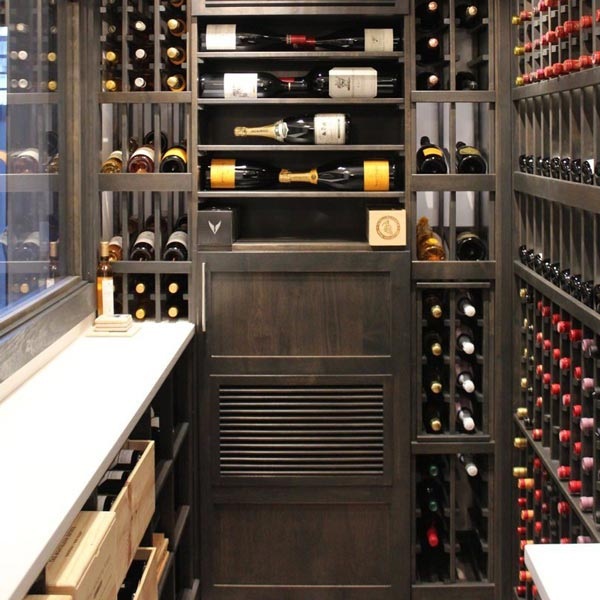How to Build a Wine Cellar
Wine Cellar Installations in Larkspur, CO
Are you interested in learning how to create your own wine cellar? Look no further than Red Leaf Solutions! We are dedicated to assisting you in constructing your ideal wine cellar, regardless of the space available or your budget. Our comprehensive Wine Cellar Construction Guide provides valuable insights into the best practices for wine storage.
Allow us to design and construct a personalized wine cellar for you. Wine cellars enhance the beauty of any home and provide practical value for wine lovers. At Red Leaf Solutions, we are driven by our love for wine and specialize in creating exquisite spaces perfect for storing and showcasing your wine collection. Contact our team today for more information about our services.
Understanding Wine Cellars
Before we start constructing your wine cellar, it’s important to understand what type you would like. There are three distinct types of wine cellars.
Underground wine cellars are built below ground level, providing natural insulation and temperature stability for wine storage. These cellars take advantage of the earth's constant temperature and high humidity levels. Underground cellars create an ideal environment for aging and preserving wine by utilizing proper insulation, ventilation, and cooling systems. They are often custom-built and offer a sense of luxury and exclusivity.
Unlike their underground counterparts, aboveground wine cellars are constructed within existing or specially designed spaces above the ground. These cellars can be incorporated into basements, spare rooms, or even dedicated areas within the home. They offer convenience and ease of access since they do not require extensive excavation or specialized construction. Proper insulation, temperature control systems, and humidity management are essential for aboveground cellars to ensure optimal wine storage conditions.
Modular wine cellars are prefabricated units that can be assembled and installed in various locations. These cellars offer flexibility and adaptability, making them an attractive option for wine enthusiasts with limited space or those seeking a portable solution. Modular cellars typically come in modular racking systems or pre-built cabinets easily configured to fit the available area. They are versatile, allowing for expansion or relocation as needed.

Optimal Wine Storage Conditions
For ideal wine storage, it is important to consider the following requirements:
Temperature
Maintain a consistent temperature between 45°F (7°C) and 65°F (18°C).
Humidity
Keep humidity levels between 50% and 70% to prevent cork issues and maintain wine quality.
Lighting
Avoid direct sunlight and intense artificial lighting, which can harm the wine. Use low-intensity, UV-resistant lighting if needed.
Planning and Designing Your Wine Cellar
The next step is to start planning and designing your personalized wine cellar. Consider the following options:
Assessing your storage needs and budget:
Evaluate your wine collection and determine how many bottles you plan to store in your cellar. Consider your budget and set realistic expectations regarding the size and features of your wine cellar. This assessment will help you make informed decisions throughout the planning process.
Determining the size and capacity of your wine cellar:
Based on your storage needs and available space, determine your wine cellar’s appropriate size and capacity. Consider factors such as future wine purchases and the potential growth of your collection. Consider the required space for aisles and accessibility within the cellar.
Selecting the appropriate racking system and layout:
Choose a suitable racking system that accommodates your bottle sizes, allows for easy access, and provides proper support and stability. Options include traditional wooden racks, metal racks, or modular racking systems. Consider the layout of your cellar, such as whether you prefer a single wall or a more intricate design with multiple display areas.
Incorporating aesthetic elements and customization options:
Enhance the visual appeal of your wine cellar by incorporating aesthetic elements and customization options. This could include choosing the right materials, finishes, and colors that complement your personal style and the overall ambiance of your home. Consider additional features like lighting, flooring, glass doors, and climate control systems to create a unique and inviting space.
The Construction Process
From here, we take over the construction and installation process. You can expect our team to go over the following aspects:
Preparing the space and obtaining necessary permits:
Ensure the designated space is suitable for constructing a wine cellar. This may involve clearing out existing items, assessing structural integrity, and obtaining any required permits or approvals from local authorities. It is essential to adhere to building codes and regulations.
Installing proper insulation and vapor barrier:
Insulation plays a crucial role in maintaining a consistent temperature within the wine cellar. Use high-quality insulation materials to prevent heat transfer and create a controlled environment. Additionally, install a vapor barrier to protect against moisture infiltration and potential mold or mildew issues.
Choosing the right cooling system for temperature control:
An appropriate cooling system is vital to maintaining the desired temperature range within the wine cellar. Depending on the size of the cellar and climate conditions, options may include self-contained cooling units, ducted systems, or split systems. Ensure the chosen cooling system is properly installed and capable of providing consistent temperature control.
Electrical and lighting considerations for a functional and appealing wine cellar:
Plan the electrical layout to accommodate lighting fixtures, cooling system power requirements, and additional electrical needs. Consider installing energy-efficient LED lighting to showcase the wine collection and create a visually pleasing ambiance. Ensure proper wiring and connections are in place to support all electrical components.
Contact Us Today
Contact our team today to get started designing your custom wine cellar.
